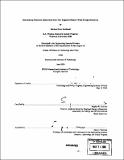Quantifying emissions reductions from New England offshore wind energy resources
Author(s)
Berlinski, Michael Peter
DownloadFull printable version (5.464Mb)
Other Contributors
Massachusetts Institute of Technology. Technology and Policy Program.
Advisor
Stephen R. Connors.
Terms of use
Metadata
Show full item recordAbstract
Access to straightforward yet robust tools to quantify the impact of renewable energy resources on air emissions from fossil fuel power plants is important to governments aiming to improve air quality and reduce greenhouse gases at least cost. It is also important to renewable energy developers seeking to gather support and facilitate permitting of their projects. Due to the inherent complexities of the electric power system, it is difficult to determine the effects of renewable energy generators on emissions from fossil fuel power plants. Additionally, because there are a variety of methods for calculating "avoided emissions," which differ in complexity and transparency, and which provide dissimilar results, there remains uncertainty in estimating avoided emissions. Guidance from government authorities on which method to use is too flexible to provide a robust framework to enable decision makers to evaluate environmental solutions. This thesis informs decision making first by highlighting important issues to consider when analyzing the impact of renewable energy resources on emissions, then by reviewing current guidance on the matter, and finally by comparing existing methods of calculating avoided emissions. Several methods are further evaluated by applying them to potential offshore wind energy resources in New England, including the proposed Cape Wind project. (cont.) This analysis suggests that the potential avoided emissions of the Cape Wind project are significant, though lower than previously stated by the project developers and supporters. The usefulness of the available literature on calculating avoided emissions suggests that governments and electric industry analysts should continue to share information on different methods and work together to revise the current guidance. To further increase analytical capacity, government agencies should collect, organize, and disseminate more data on the electricity system including power plant operations and emissions. The ability to accurately quantify avoided emissions will help policymakers design programs with the right incentives to reduce emissions from power plants and will enable them to describe the environmental benefits of doing so. To facilitate development of clean energy resources, it is proposed that more weight is given to environmental benefits such as avoided emissions in environmental impact assessments. To assist in reducing emissions, it is recommended that renewable energy and energy efficiency resources are allowed to participate more directly in emissions markets.
Description
Thesis (S.M.)--Massachusetts Institute of Technology, Engineering Systems Division, Technology and Policy Program, 2006. Includes bibliographical references (p. 74-76).
Date issued
2006Department
Massachusetts Institute of Technology. Engineering Systems Division; Technology and Policy ProgramPublisher
Massachusetts Institute of Technology
Keywords
Technology and Policy Program.